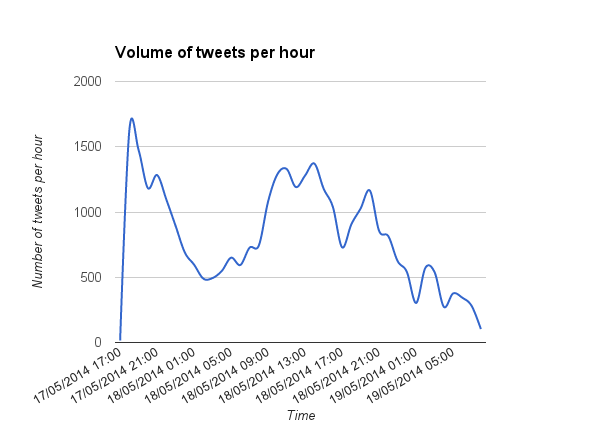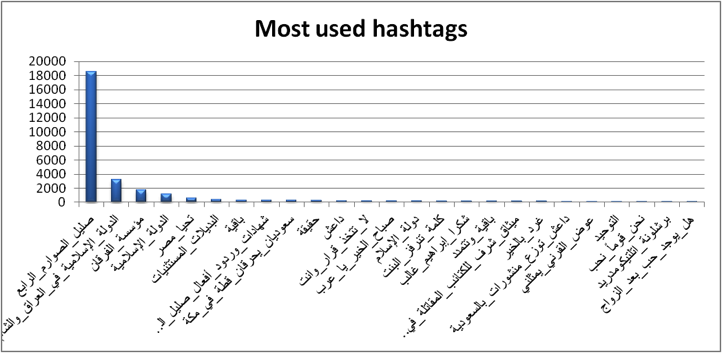The release of the video Salil al-sawarim (SaS) by ISIS’s media department al-Furqan over the weekend demonstrated the sophistication of the jihadist use of social media to disseminate their video content. Al-Furqan’s sister department, al-I’tasimu had announced the release of the fourth instalment of Sas on Twitter on Saturday noon, March 17, 2014. A few hours later, it was published via al-I’tasimu’s high-profile Twitter account and the tier-one jihadist forums. The first three Salil al-sawarim videos had been very popular, high quality edited and showed a mix of extreme obscene violence and ideology at play.
This is the first part of the brief glimpse into the data collected on Twitter revolving around the #صليل_الصوارم_الرابع Ali Fisher and Nico Prucha explore the data networks and outline in brief terms the ideological bearings at play. For a second post we will provide the readers with a more in depth analysis, outlining the context of this video in the jihadist virtual as well as the greater ideological cluster at play.
In the first twenty four hours after Sas (“The Clanging of the Swords”) was posted on YouTube the was viewed 56,998 times with an average user watching a little over 17 minutes of the hour long film. This means that collectively YouTube users spent the equivalent of 686 days watching this one video. It has subsequently been reposted a number of times on YouTube, and was published on other file sharing sites such as archive.org and links for download were broadcast via justpaste.it. It was published in different sizes and formats. A high-definition format, about one gigabyte in size, carries death and mayhem to the home and portable cinemas worldwide.
As of writing this post, the YouTube video has been viewed 124,704 times with 4,204 likes and 491 dislikes.
Delivering high levels of views in the first day after publication takes coordination across a range of social media channels. This briefing analyses that spread of information, and shows:
- The volume of tweets about the video release.
- An estimate of the size of the network which shared word of the video release.
- The users most frequently mentioned in connection with the video.
- The key actors in the Twitter network that allowed word of the video release to spread rapidly.
- The platforms that users utilised to tweet.
- The prominent languages used to spread word of the video release.
This shows:
- Jihadist groups have become increasingly sophisticated in their use of social media and mobile technologies.
- The release of the video on a Saturday may have been a deliberate strategy to pick the day when those employed to challenge or disrupt the propagation of information about the video were least likely to be available.
- Information is shared through a resilient and dispersed network. This network has sufficient interconnection and redundancy to continue to operate despite the current level of account suspensions.
The video
In short the approximate one-hour long video is a mix of implementing ideological principles and executing framed enemies. The film starts with several ISIS Mujahideen who tear up their Kosovar passports and burn these. A ring leader outlines the principles of the true Islamic state citizenry in fluent Arabic – an element that was just recently broadcast in two al-Furqan videos where several international fighters tore up their passports to declare their identity and belonging to the Islamic State and not to some vassal or Crusader state entity. The opening of the video enforces the connection of Syria and Iraq: ISIS armed car convoys parading in cities such as Homs, Raqqa, switching to Fallujah where a drone, possibly an Parrot AR.Drone iPad controlled remote aircraft, is flown above the convoy, proving the audience with a 360 angle view of the city and the jihadi boots on the ground.
All operations in the video are allegedly in Iraq, in the notorious al-Anbar province, including the cities of Ramadi and Fallujah where the most severe attacks against the U.S. forces at the time occurred. Iraqi governmental officials are sought out at fake checkpoints and executed, off-duty soldiers are hunted down on the streets and killed for reasons varying from being an apostate of Sunni Islam to being a Shiite or of collaborating with the U.S. funded Sunni Sahwa councils at the time. ISIS, by these specific search-and-destroy missions claims to have insider information and conveys to the audience that all assassination operations are meticulously planned and carried out. Part of these cleansing operations include ISIS units searching the private houses of Iraqi governmental soldiers and officers, who often are visibly confused as ISIS dresses up just like legitimate governmental units. The surprised individuals are then tied up and shot, or beheaded, guilty based on TV-reports and uniforms etc. found in their house – a typical modus operandi often seen in this type of video.
Other parts of the video show how the element of repentance (tawba) is enforced on the local Sunni population of al-Anbar. This is a lesson learned that is already at play in Syria: why alienate the local Sunni people when they can be coerced into inclusion, forcing them to repent their former affiliation or sympathies with the local governments. ISIS gathered what appears to be several hundred men to mosques where preachers declare the Mujahideen are fighting for the Sunni people, demanding that those present dissociate themselves from worldly or Shiite rule etc. ISIS seeks to recruit and integrate by killing off individuals framed as responsible for grievances while empowering the ‘former victims’ by granting them forgiveness and a place among them.
Distribution
Word of the video release spread via Twitter with two distinct peaks in Tweeting. One peak occurred on the day of release (17th May) and a second during the following day (18th May).
Between the 17th May and 8am on the 19th May we observed a total of 32,313 tweets carrying the name of the video. There was an average of 807.825 tweets per hour, the median being 736.5.
Tweets contained a range of #tags in addition to the title of the video, the most common of which are shown below.
The first hash tag on the left is the Arabic reference to Salil_al-sawarim_four, followed by The_Islamic_State_in_Iraq_and al-Sham, and the al-Furqan Media department.
However, while all the prominent tags are in Arabic, not all the tweets were in Arabic. This demonstrates the reach of the video and shows that some multilingual users were proactively translating content allowing users to access the information in a range of languages.
Users were also using a range of different technologies through which to tweet but mobile technologies and particularly phones are dominant. The most common ways users tweeted about the video was an app on an Android mobile phone, (Twitter for Android) followed by an iPhone app, (Twitter for iPhone). The web and tablets are also important but to a lesser extent.
As the graph shows, word of the video on YouTube, and archive.org was spread using a range of different digital technologies, including mobile phones, desktop (web), and via other social media including Facebook. This last case emphasises the importance of understanding the jihadist social media phenomenon as a cross platform zeitgeist, as users were using Facebook to tweet about a video posted on YouTube.










3 Responses